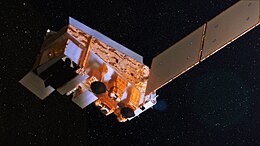Suomi NPP

Suomi NPP
|
|
| Mission type | Meteorology |
|---|---|
| Operator | NASA / NOAA / DoD |
| COSPAR ID | 2011-061A |
| SATCAT no. | 37849 |
| Mission duration | 5 years |
| Spacecraft properties | |
| Bus | BCP-2000 |
| Manufacturer | Ball Aerospace |
| Launch mass | 2,128 kilograms (4,691 lb) |
| Dry mass | 1,400 kilograms (3,100 lb) |
| Payload mass | 464 kilograms (1,023 lb) |
| Dimensions | 1.3 m x 1.3 m x 4.2 m |
| Start of mission | |
| Launch date | 28 October 2011, 09:48:01.828 UTC |
| Rocket | Delta II 7920-10 D357 |
| Launch site | Vandenberg SLC-2W |
| Contractor | United Launch Alliance |
| Orbital parameters | |
| Reference system | Geocentric |
| Regime | Sun-synchronous |
| Semi-major axis | 7,204.0 kilometers (4,476.4 mi) |
| Perigee | 833.7 kilometers (518.0 mi) |
| Apogee | 834.3 kilometers (518.4 mi) |
| Inclination | 98.7 degrees |
| Period | 101.44 minutes |
| Epoch | 25 January 2015, 00:35:06 UTC |
The Suomi National Polar-orbiting Partnership or Suomi NPP, previously known as the National Polar-orbiting Operational Environmental Satellite System Preparatory Project (NPP) and NPP-Bridge, is a weather satellite operated by the United States National Oceanic and Atmospheric Administration. Originally intended as a pathfinder for the NPOESS programme, which was to have replaced NOAA's Polar Operational Environmental Satellites and the U.S. Air Force's Defense Meteorological Satellite Program, Suomi was launched in 2011 after the cancellation of NPOESS to serve as a gapfiller between the POES satellites and the Joint Polar Satellite System which will replace them. Its instruments provide climate measurements that continue prior observations by NASA's Earth Observing System.
The satellite is named after Verner E. Suomi, a meteorologist at the University of Wisconsin–Madison. The name was announced on January 24, 2012, three months after the satellite's launch.
The satellite was launched from Space Launch Complex 2W at Vandenberg Air Force Base in California by a United Launch Alliance Delta II 7920-10C on October 28, 2011. The satellite was placed into a sun-synchronous orbit 824 km (512 miles) above the Earth.
NPOESS Preparatory Project (NPP) is intended to bridge the gap between old and new systems by flying new instruments, on a new satellite bus, using a new ground data network. Originally planned for launch five years earlier as a joint NASA/NOAA/DOD project, NPP was to be a pathfinder mission for the larger National Polar-orbiting Operational Environmental Satellite System until DOD participation in the larger project was dissolved. The project continued as a civilian weather forecasting replacement for the NOAA Polar Operational Environmental Satellites (POES) series, and ensured continuity of climate measurements begun by NASA's Earth Observing System.
...
Wikipedia
